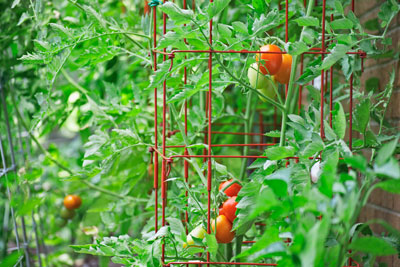
Written by Ingrid Hoff
I am a complete self-described tomato snob. I am such a tomato snob that I avoid eating fresh store-bought tomatoes through the winter. Once you’ve tasted the glory of a vine-ripened, still warm from the sun, tomato off your own vine, well you just haven’t lived.
There are a few things to consider if you want to grow the sweetest, juiciest, plumpest tomatoes possible. Here are my top tips for growing tomatoes:
Tomato Timing
They like it HOT. If you don’t have 6-8 hours of sunlight then you aren’t going to have much success. Tomatoes are native to Mexico, Central and South America, they are adapted to perform in warm weather, so give them what they need.
Generally, when nighttime temperatures are reaching 10°C minimum (usually after Mother’s Day) then we are all in the clear to get planting. Also, these are great crops to grow in containers (black plastic heats up very well) or raised beds since the elevated soil will warm up faster in the spring.

Summers are short in Canada so know your days to maturity. Days to maturity is just what it sounds like, how many days it’s going to take until you are eating tomatoes. If you choose a variety with a low days to maturity (early ripening) then you are going to get more tomatoes out of our shortened season. Cherry and grape types are a good option or read your labels and look for clues in the variety name, like Early Girl.
Planting
Don’t crowd them, tomatoes need space. They don’t like competition, so if you plant them to close to each other, your yield will suffer. A dense thicket of tomatoes also means less airflow and that leads to diseases. So, pay attention to the planting instructions on the label and make sure they are free to grow.
Plant them deep, tomatoes can produce something called adventitious roots, which is a fancy word for able to grow roots from the above ground part of the plant. If you look closely at a tomato stem you’ll see a number of bumps, these are sites where new roots can develop. So, if you bury them, then new roots will form. A good strong root system is going to mean a healthier, stronger plant and more tomatoes for the smart gardener. This is especially important if you have a tall, leggy tomato.
Supporting Your Plants
Even though these plants like it hot they still need even watering. A flood and drought cycle can cause the skins of tomatoes in particular to grow unevenly and then split. If you are not the most diligent waterer, consider mulching, it will help the soil moisture remain constant.

Feed your plants. There are a variety of fertilizers to choose from, both organic and conventional, that are formulated for tomatoes or other “fruiting” veggies (with a lower nitrogen component). We recommend GARDENWORKS Organic Vegetable & Tomato Food 3-1-4. Another option is to consider amending your soil with a mycorrhiza or composted material. Proper plant nutrition is also how you avoid a problem called blossom end rot (your tomatoes literally rot starting on the ends of the fruit). This happens when there is not enough calcium available for the plant and is especially a problem for tomatoes grown in a container. It’s easy to remedy, just use fertilizer specially formulated with calcium and magnesium.
Support your plants, as in literally give them something to grow on or they might fall over. When the fruit (yep, tomatoes are fruit) start to ripen they are heavy and can snap the stems of the plant. This is especially important if you are growing an indeterminate tomato (one that does not stop growing up). Choose a tomato cage, trellis or gently tie to stake (so as to not crush the tender stems).

Prune your plants, tomatoes have something called sucker vines, which are little shoots growing out of the joint where a branch meets the main stem (called the crotch). These sucker vines can suck energy away from fruit production, so pinch them out when you see them. Also remove bottom leaves since they are usually shaded by the other branches so not much use for photosynthesis and end up just being a site for potential disease.
Speaking of disease, let’s talk about late blight. Blight is a foliar fungal disease and almost all tomatoes get it, usually near the end of the growing season. This is because the spores for the disease are everywhere, you can’t avoid them. When they hit the combination of the right temperature and water the fungus starts to grow and your tomato looks like a black soggy rotten mess.
Preventing Blight:
- The best thing to do is prevent the fungus from growing by making sure water isn’t sitting on the leaves for extended length of time.
- When watering try to keep the water on the soil where it’s needed.
- Prune your tomatoes to improve air circulation.
- Consider a structure over your tomatoes to keep the rain off (but make sure it’s open at the bottom to ensure air circulation).
So, now you know how to grow your own delicious garden-fresh tomatoes, the only thing left to do is choose what you want to grow. But be warned, once you go garden-grown you can never go back.
For further reading, check out our blog on Companion Planting.




